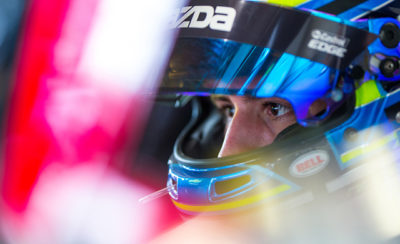There are a lot of sensations, sights, sounds and sometimes smells to deal with in a race car. Filtering out what doesn’t matter helps you focus on what’s important.
“There are 1,000 channels of information coming at you and you have to figure out what are the most important ones,” explained GT racer Andy Lally. “There are probably 20 important things and all the rest are white noise. You kind of check off the box – OK, that vibration is fine, that little bit of slide, that compliance, that rebound … all those things are OK; check it off the list and think, ‘OK, next time I feel that, I can ignore it.’ You focus and whittle down to the things you need to feel.
“You have to figure it out – is it the tire, or the car,” Lally continued. “Is the tire always going to do that or is there something that I can do with the shock, the spring, the swaybar to make the car better? The answer is almost always ‘yes.’
“Start with the things that touch the ground and move up from there,” explains Mazda factory driver and driver coach Tom Long, speaking on how to focus on the important stuff. “Think about the tires and the contact patch … if it’s a vibration, maybe it’s pickup on the tire, maybe a flat spot, maybe an imbalanced wheel. Then move that up into the suspension – springs, swaybars, dampers.”
The idea is to focus on things you can do something about and ignore the rest. Much of that comes with experience, says 2017 USF2000 champion Oliver Askew. But comparing lap times with others to see how you stack up may indicate that what you’re feeling isn’t really a problem, he notes.
“Maybe you can only get so much out of it,” says Askew. “If you’re feeling something that’s consistent, that’s not changing when you work on the car, if that issue is not changing and you’re still competitive, maybe the track conditions and tire translate to that issue. That’s a telltale sign that there’s nothing you can do about it.”
Speaking of conditions, that’s another thing a driver has to put out of his or her mind – they are what they are, and a driver just has to deal with it. Askew cites a couple of corners at Sebring that get greasier than others in the heat, and coupled with a bit of off-camber, can be pretty tricky. “I know this corner is going to be oversteer-y at this time of day and this track temperature, and there’s nothing we can do about it. Just move on, deal with it and work on other parts of the track,” he says.
For some drivers, though, just moving on isn’t always so simple. Once it gets into your brain, it’s easy to obsess about an inconsequential car behavior that you can’t do anything about. Long has a few ideas about that topic.
“If you’re distracted by something, you need to get back in your rhythm,” says Long. “The way to do that would be focusing on your points. I’m looking at my brake points and I’m going to focus on that; the gear I want to use in the corner; getting a good run off the corner. Focus your mind on the things you want to do and push out the negative aspects so that keeps you focused.”
If whatever odd thing you’ve noticed isn’t something you can fix, move on. If it is, make a mental note to deal with it after the session and drive around it. Keep the focus on what’s important at the moment and you’ll get the most out of the time on track.


 ACCESSIBILITY
ACCESSIBILITY